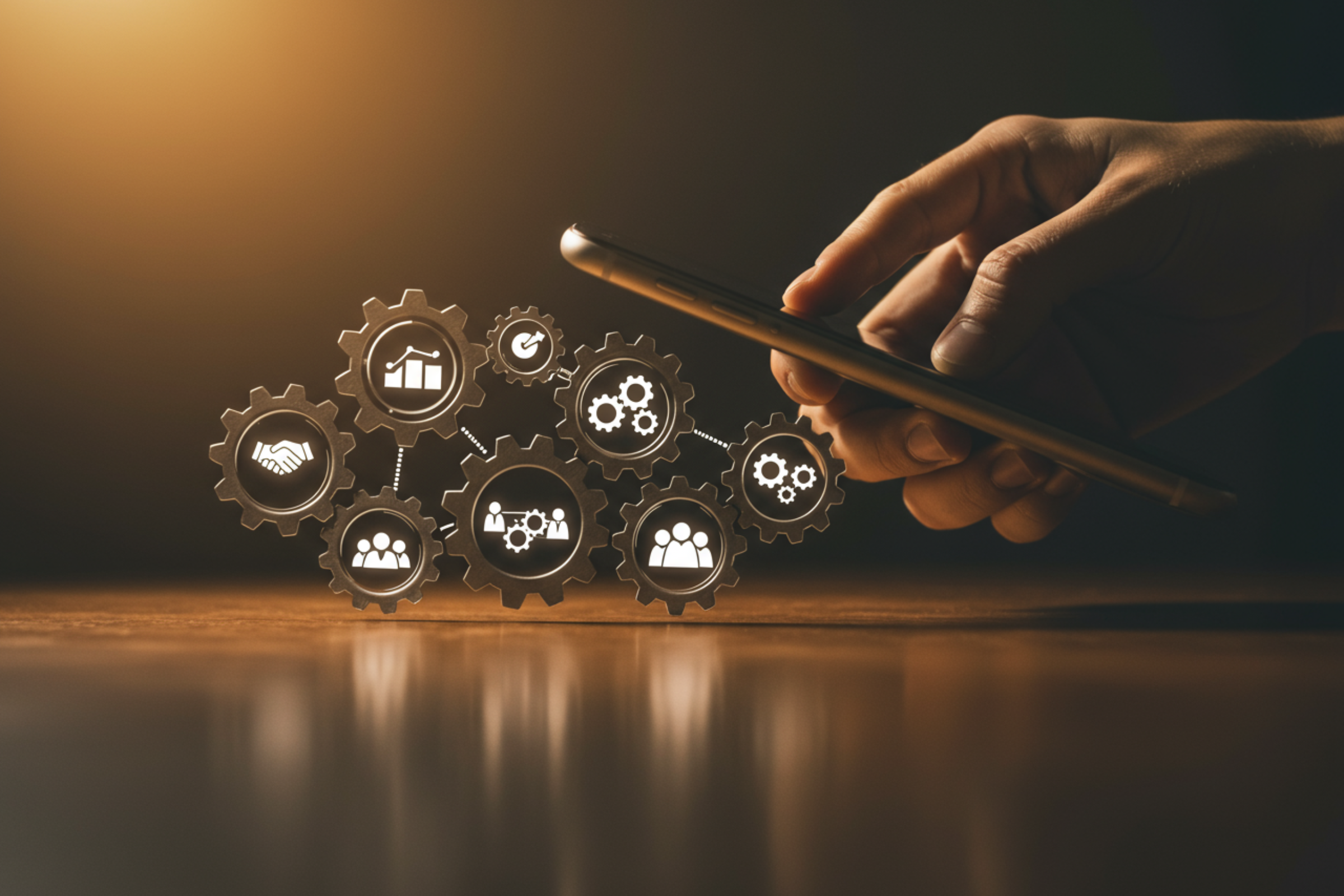Marketing 101: Mastering B2B Buying: Essential Strategies and AI Tools for Small Business Growth
- Key Differences: B2B vs. B2C Markets Explained
- Unpacking B2B Demand: Dynamics and Market Shifts
- Identifying and Engaging Different Types of B2B Buyers
- Navigating the Complexities of B2B Purchasing Decisions
- Harnessing AI Marketing for Smarter Content Creation and Sales
- Actionable Takeaways: Positioning Your Business for B2B Success
This Marketing 101 blog series is based on our podcast, Effortless Marketing for Small Business Owners with Hailey Hodge. If you would like to listen to the podcast episode that this blog post is based on, you can listen on Spotify or Apple Podcasts!
For small businesses, grasping the nuances of Business-to-Business (B2B) buying isn’t just a theoretical exercise—it’s a practical necessity. Unlike consumer-focused markets, B2B transactions often represent a significant portion of a company’s revenue, with fewer buyers but larger sales volumes. This means every relationship, negotiation, and contract can have a profound impact on long-term stability and growth.
In the B2B world, small businesses encounter both hurdles and openings. The complexity of B2B purchasing, with its longer sales cycles and multiple stakeholders, can seem daunting at first. However, this complexity also presents opportunities: by understanding how businesses buy, small firms can tailor their approaches, stand out with personalized service, and build partnerships that last.
Additionally, market needs are constantly evolving. Informed small business owners who stay attuned to B2B buying trends can better anticipate shifts, adapt their offerings, and position themselves as valuable partners rather than just vendors. This proactive approach lays a strong foundation not only for sales, but also for marketing strategies that resonate with business buyers.
Ultimately, mastering B2B buying knowledge levels the playing field. It enables small businesses to compete effectively against larger competitors, leveraging agility, creativity, and relationship-building as key assets. By prioritizing an understanding of the B2B landscape, small businesses set themselves up for more consistent growth and deeper market influence.

Key Differences: B2B vs. B2C Markets Explained
- Transaction volume and value differ between B2B and B2C.
- B2B products/services are often more complex and customizable.
- Longer sales cycles and multiple stakeholders in B2B.
- Personal selling and relationship management are central in B2B.
- B2B buyers have higher expectations for customization and support.
At first glance, B2B and B2C markets might appear similar—after all, both involve buyers and sellers exchanging goods or services. However, the differences run deep and significantly shape how small businesses should approach each market.
In B2B, transaction volumes are substantial, but the number of buyers is typically lower than in B2C. Each B2B customer often accounts for a significant share of sales, making every relationship critical. The products and services offered in B2B contexts tend to be complex, expensive, and frequently require some degree of customization to fit the client’s specific needs. This complexity naturally leads to more involved decision-making processes, with multiple stakeholders—such as end-users, technical approvers, finance officers, and executives—playing roles in the final purchase.
Unlike B2C, where impulse buys and emotional triggers can drive quick decisions, B2B purchasing is methodical and deliberate. Sales cycles are longer, and buyers expect a higher level of personal attention. Building trust and fostering close vendor relationships is not just beneficial; it’s often essential for winning and retaining business clients.
Moreover, B2B buyers demand more than just a product; they seek tailored solutions, ongoing support, and assurance that their investment will deliver value over time. For small business owners, recognizing these differences enables more effective marketing, sales strategies, and customer service, ultimately leading to stronger, longer-lasting business relationships.

Unpacking B2B Demand: Dynamics and Market Shifts
- B2B demand is derived from consumer demand.
- The "bullwhip effect" impacts supply chains.
- Joint demand connects related products.
- Companies can influence end-consumer demand indirectly.
- Understanding demand dynamics aids strategic planning.
B2B demand isn’t created in a vacuum—it’s closely tied to the ebb and flow of consumer markets. This phenomenon, known as “derived demand,” means that when consumer preferences shift, the ripple effects can dramatically influence the types and quantities of products businesses need. For example, a surge in smartphone sales leads to increased demand for components like processors, screens, and batteries from various suppliers.
One important dynamic to be aware of is the “bullwhip effect.” Here, even small fluctuations in consumer demand can trigger amplified changes up the supply chain, causing suppliers and manufacturers to adjust their orders, sometimes erratically. For small businesses, understanding this effect is crucial for managing inventory, forecasting demand, and staying agile in the face of market shifts.
Additionally, B2B markets are often shaped by “joint demand.” This occurs when the demand for one product directly increases the need for a complementary product. A classic example is video game consoles and video games—when the former sells well, so does the latter.
Interestingly, some B2B companies don’t just respond to consumer demand; they actively influence it. For instance, a chip manufacturer may run consumer-facing campaigns to drive awareness, thereby increasing demand for their products among device manufacturers.
For small business owners, recognizing these interconnected demand dynamics is vital. It allows for more accurate market predictions, smarter inventory management, and strategic planning that anticipates—not just reacts to—market changes.

Identifying and Engaging Different Types of B2B Buyers
- Overview of four main B2B buyer types: producers, resellers, government, institutions.
- Producers use goods to create other products or services.
- Resellers buy and sell goods without altering them.
- Government is a massive, regulated buyer with unique requirements.
- Institutions focus on cost control and value.
Not all B2B buyers are created equal. Understanding the distinct categories of buyers helps small businesses tailor their approach and maximize the chances of successful partnerships.
Producers are manufacturers and service providers that purchase goods and services to create their own products. For example, a software developer might buy cloud services or a manufacturer may source raw materials. For small businesses, serving producers often means offering solutions that directly enhance production efficiency or product quality.
Resellers—including wholesalers, brokers, and retailers—purchase finished goods to sell them without modification. While landing a contract with a large reseller (think national retail chains) can rapidly boost sales, it also brings challenges like pricing pressures and strict compliance with terms.
Government buyers represent the largest and most varied purchasing group. From local municipalities to federal agencies, governments require everything from office supplies to advanced technology. However, selling to government entities often involves navigating complex procurement processes, strict regulations, and patience for longer buying cycles.
Institutions such as hospitals, non-profits, and educational organizations are another significant segment. These buyers prioritize cost control, value, and reliability. Small businesses succeed here by offering competitive pricing, clear value propositions, and responsive service.
By identifying which buyer type aligns best with their offerings, small businesses can focus their marketing and sales efforts more effectively, ensuring higher conversion rates and lasting client relationships.

Navigating the Complexities of B2B Purchasing Decisions
- B2B purchases involve multiple stakeholders (the DMU).
- Stakeholder roles: end-users, influencers, approvers, budget holders.
- Each role has unique priorities (quality, price, service, compliance).
- Trust and relationships heavily influence outcomes.
- Success requires clear communication and tailored value propositions.
The process behind B2B purchasing is rarely straightforward. Unlike consumer purchases, where a single person often makes the decision, B2B buying typically involves a group known as the Decision-Making Unit (DMU). This group might include end-users, technical advisors, financial officers, and top-level executives—all of whom bring their own perspectives and priorities to the table.
Each stakeholder evaluates the purchase through a different lens. End-users may focus on functionality and ease of use, finance teams look at cost-effectiveness, while IT departments scrutinize security and compliance. This diversity of concerns means small businesses must address a wide range of questions and objections throughout the sales process.
Trust and personal relationships are especially influential in B2B transactions. Building rapport, demonstrating reliability, and maintaining transparent communication can often tip the scales in your favor, especially when competing against larger firms with more resources.
For example, selling software to a healthcare provider might involve product demonstrations for users, financial discussions with procurement officers, compliance checks by legal teams, and final sign-off from executives. Each stage requires tailored messaging and an understanding of what each stakeholder values most.
Patience, strategic communication, and a willingness to adapt are key. By presenting clear, customized value propositions that align with the client’s goals, small businesses can navigate complex buying processes and secure lasting partnerships.

Harnessing AI Marketing for Smarter Content Creation and Sales
- AI streamlines content creation for targeted messaging.
- Real-time analytics aid in anticipating market trends and buyer behavior.
- AI automates repetitive marketing tasks, boosting efficiency.
- AI personalizes outreach (emails, social media) for higher engagement.
- AI helps identify key decision-makers and predict purchasing patterns.
Artificial Intelligence (AI) is rapidly transforming the B2B marketing landscape, offering small businesses tools once accessible only to large enterprises. By integrating AI into their marketing strategies, small businesses can work smarter, not harder.
One of AI’s standout benefits is its ability to simplify content creation. AI-powered platforms can generate customized content for emails, social media, and blogs—tailoring messages to specific buyer segments for maximum impact. For instance, a bakery might use AI to analyze customer purchase history and send personalized offers that drive repeat business.
Real-time analytics is another game-changer. AI tools can sift through massive data sets to identify emerging market trends and anticipate buyer behavior. This insight enables small businesses to stay ahead of the curve, adjusting their strategies proactively rather than reactively.
Repetitive tasks such as scheduling social posts, sending follow-up emails, or segmenting email lists can be automated with AI, freeing up valuable time and resources. This efficiency allows small business owners to focus on relationship-building and creative problem-solving.
AI also excels in identifying key decision-makers within target organizations and predicting purchasing patterns, making outreach efforts more precise and effective. While there is a learning curve and considerations around data privacy, the advantages—greater efficiency, higher engagement, and increased revenue—far outweigh the challenges.
By leveraging AI marketing tools, small businesses can level the playing field, delivering compelling, personalized experiences that drive growth and foster lasting client relationships.

Actionable Takeaways: Positioning Your Business for B2B Success
- Stay informed about B2B buying behaviors and market dynamics.
- Tailor marketing and sales strategies for different B2B buyer types.
- Build relationships and trust with multiple stakeholders.
- Use AI tools for content creation, analytics, and marketing automation.
- Embrace innovation to drive efficiency and growth.
Achieving success in B2B markets isn’t about mastering a single tactic—it’s about adopting a holistic, informed approach. Here are key actions small businesses can take to thrive:
- Stay Educated: Continuously learn about B2B purchasing behaviors and evolving market dynamics. This knowledge enables you to anticipate changes and adapt your strategies accordingly.
- Segment and Target: Clearly identify which types of B2B buyers best match your products or services. Develop tailored marketing messages and sales approaches for producers, resellers, government agencies, and institutions.
- Build Trust: Invest in relationship-building with all stakeholders involved in the decision-making process. Transparent communication, reliability, and understanding client goals go a long way in securing and retaining business.
- Leverage AI Tools: Incorporate AI-powered solutions for content creation, real-time analytics, and marketing automation. These tools not only streamline operations but also enhance your ability to deliver personalized, engaging experiences.
- Innovate and Evolve: Stay open to adopting new technologies and strategies. Embracing innovative tools such as AI helps you remain agile, efficient, and competitive in a rapidly changing marketplace.
By understanding the intricacies of B2B buying and harnessing the power of modern marketing technologies, small businesses can position themselves for sustained growth, stronger client relationships, and greater success in competitive B2B landscapes.